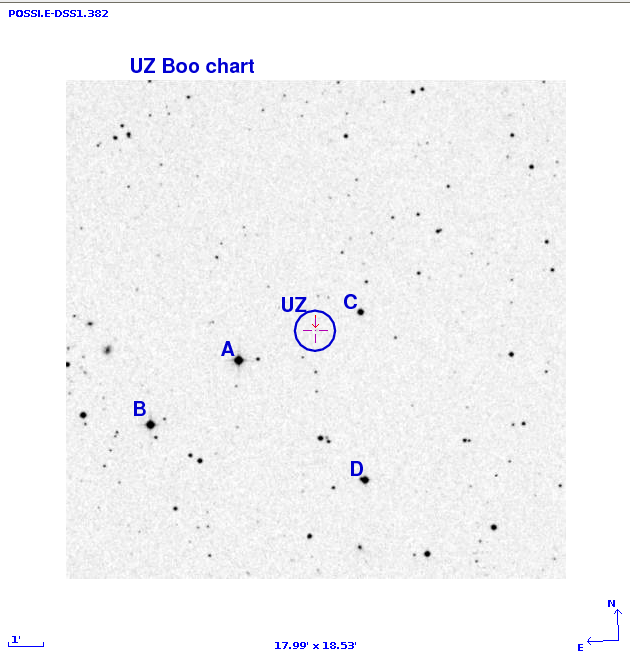
On the night of July 26/27, 2013, I observed the the cataclysmic variable star UZ Boo; as a bonus, I took some images of the Type II supernova 2013ej in M74, which had just been discovered! The weather was fairly good, with just a few small passing clouds.
The main setup was:
Notes from the night
The cataclysmic variable star known as UZ Boo is now in outburst, first noticed this time around July 26. Here's a chart from the Digitized Sky Survey.

When pointing at this object, the finder scope produces a picture like the following on the TV screen:
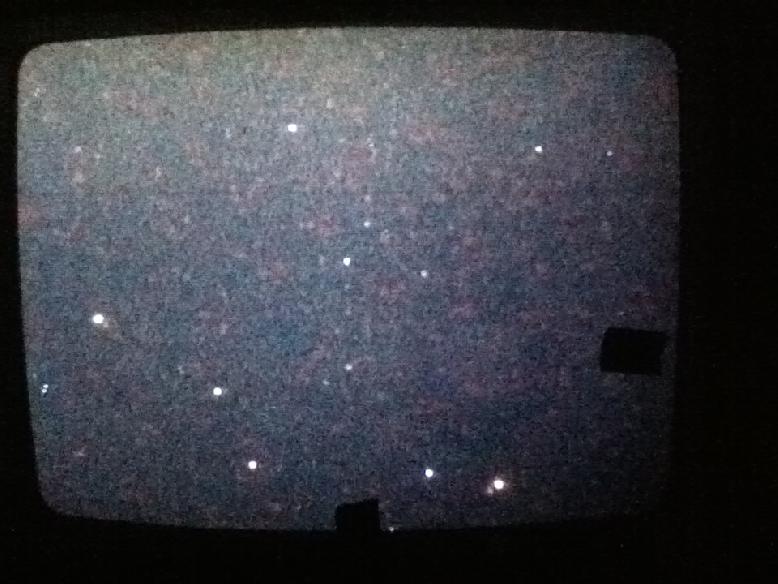
I took a set of 30-second guided exposures. I discarded some of the images, leaving 180 good ones.
Below is one of my images:
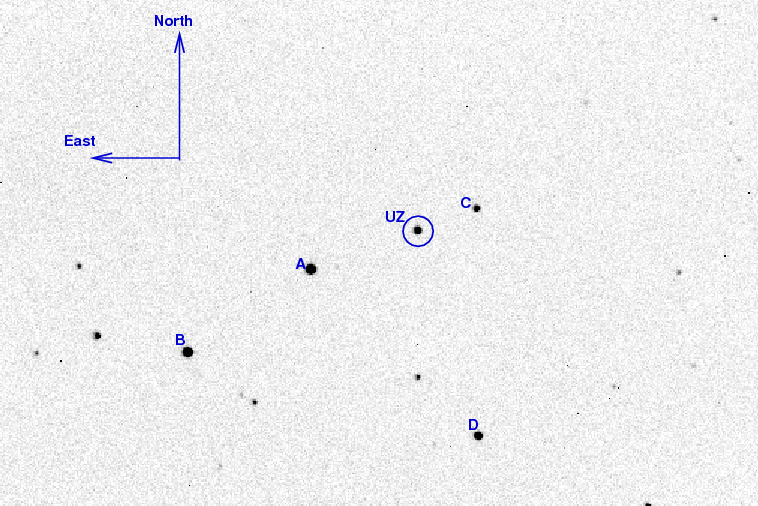
Using aperture photometry with a radius of 4 pixels (radius of 7.4 arcsec), I measured the instrumental magnitudes of a number of reference stars and the target. Following the procedures outlined by Kent Honeycutt's article on inhomogeneous ensemble photometry, I used all stars available in each image to define a reference frame, and measured each star against this frame. I used the AAVSO's V-band magnitude for star "A", V = 11.094, taken from their chart 12447AMF, to convert the ensemble instrumental magnitudes to the standard V-band scale.
The graph below shows the change in zeropoint from image to image.
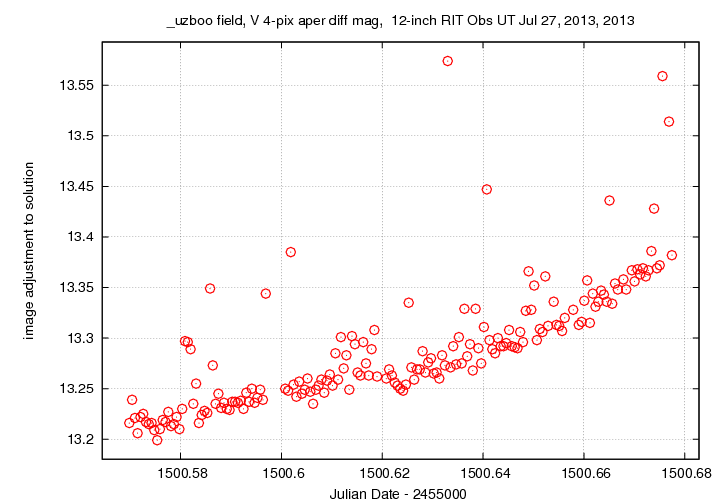
The scatter as a function of instrumental magnitude shows that the brightest unsaturated stars had a scatter of about 0.005 mag. The target, at instrumental magnitude 1.3, has a scatter of 0.11 mag, which is not elevated above the locus of non-variable stars.
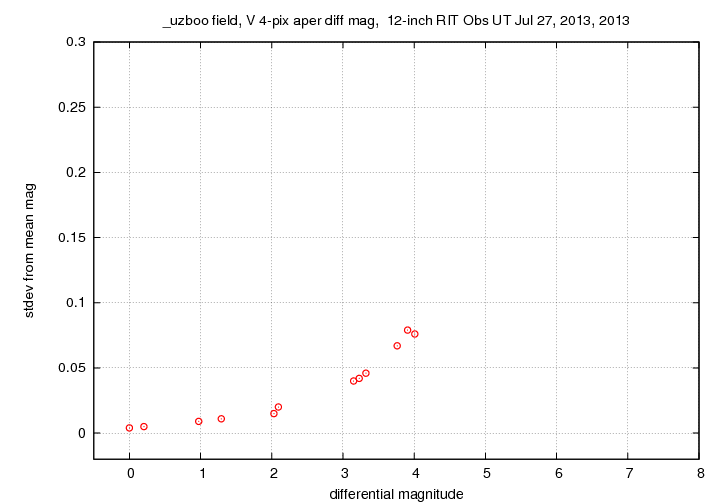
Here are light curves of the target star (green crosses) and some of the other stars in the field.
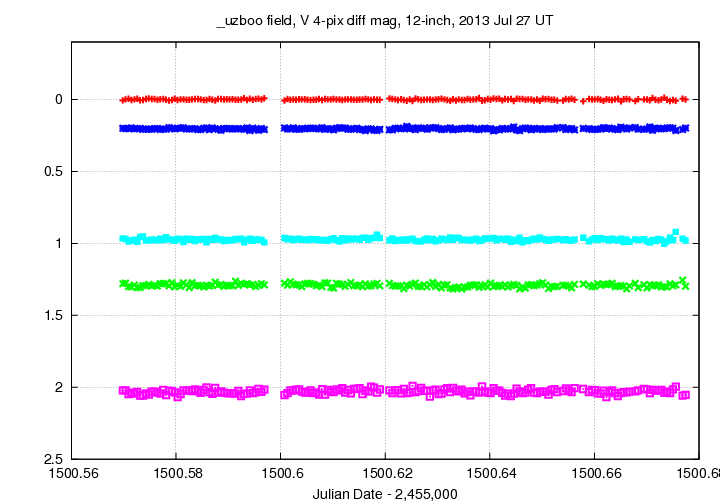
Here's a closeup of the target (green crosses) and a star D.
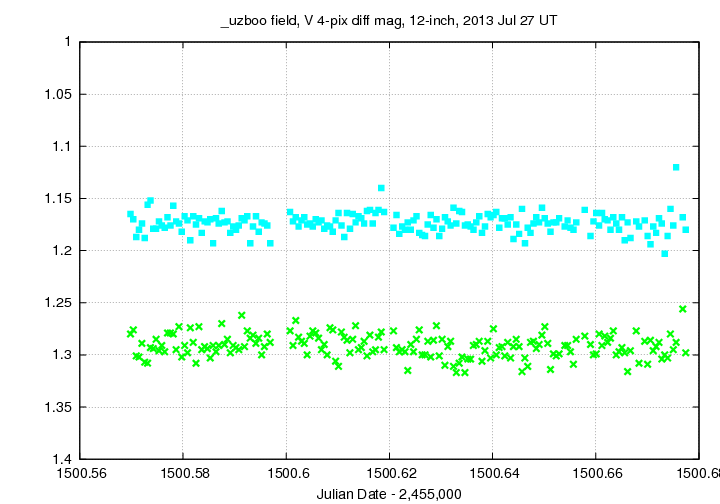
The amplitude of variations in UZ Boo is so small that they don't appear in this dataset; at least, not to the eye.
I sent a message to cba-data with the following report. This shows only the first few lines of measurements -- the full set can be retrieved using the link below.
# Measurements of UZ_Boo made at RIT Obs, Jul 27, 2013 UT, # in good conditions, # by Michael Richmond, using 12-inch Meade and SBIG ST-8E CCD. # Exposures 30 seconds long, V filter. # Tabulated times are midexposure (FITS header time - half exposure length) # and accurate only to +/- 1 second (??). # 'mag' is a differential magnitude based on ensemble photometry # using a circular aperture of radius 7.4 arcseconds. # which has been shifted so UCAC4 561-055134 has mag=11.094 # which is its V-band magnitude according to AAVSO. # # UT_day JD HJD mag uncert Jul27.06983 2456500.56983 2456500.56952 12.374 0.009 Jul27.07037 2456500.57037 2456500.57006 12.370 0.010 Jul27.07093 2456500.57093 2456500.57062 12.395 0.010 Jul27.07148 2456500.57148 2456500.57117 12.396 0.010
Early images of SN 2013ej in M74
When I arrived at the Observatory in the early evening, I checked my E-mail. There was a notice from Patrick Schmeer that a transient object had been seen near the galaxy M74, and that the object was on the Transient Objects Confirmation Page. If real, this could be a young supernova in a relatively nearby galaxy!
[vsnet-alert 16056] Magnitude 12.4 Supernova in M74? Sent: Friday, July 26, 2013 7:33 PM To: vsnet-alert@ooruri.kusastro.kyoto-u.ac.jp; cvnet-outburst@yahoogroups.com; baavss-alert@yahoogroups.com PSN J01364816+1545310: a possible mag 12.4 supernova in M74 http://www.cbat.eps.harvard.edu/unconf/followups/J01364816+1545310.html Clear skies, Patrick
The object didn't rise until after midnight, so I had to wait for a bit. When it did rise (and after it passed through the branch of a big tree), I managed to acquire some images in all four filters, BVRI. The conditions weren't great, since the object was so low in the sky and close to the nearly full Moon, but the new object was clearly present!
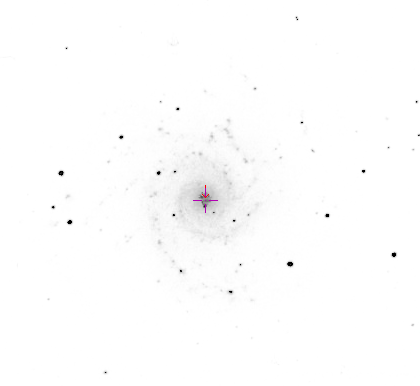
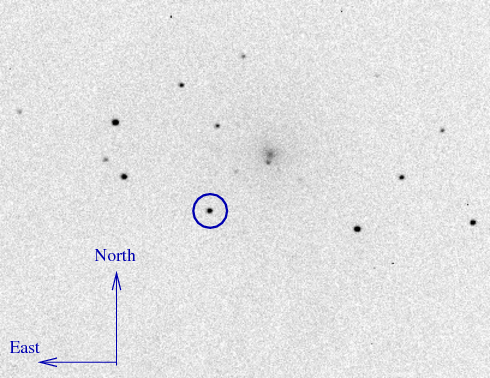
Above to the left is an image of M74 from the Digitized Sky Survey. On the right is one of my R-band images. I've circled the new object, which lies just south-east of one of the spiral arms.
Many observers turned their attention to this object over the next few hours, and an IAU Circular was soon issued to announce that this was, in fact, a supernova; in fact, a young Type II supernova.
SUPERNOVA 2013ej IN M74 = PSN J01364816+1545310
Further to CBET 3588, M. Kim, W. Zheng, W. Li, and A. V. Filippenko,
University of California at Berkeley; and S. B. Cenko, Goddard Space Flight
Center, report the LOSS discovery of an apparent supernova in M74 = NGC 628
on unfiltered KAIT images:
SN 2013 UT R.A. (2000.0) Decl. Mag. Offset
2013ej July 25.45 1 36 48.16 +15 45 31.0 13.5 92".5 E, 135" S
The object was observed again on July 26.44 UT at mag 13.1, having increased
about 0.4 mag in one day, indicating that it may be a young supernova on the
rise. No other KAIT observations were made in the past several months,
prior to July 25. A finding chart is posted at the following website URL:
http://astro.berkeley.edu/~zwk/findingchart/PSN_J01364816+1545310.jpg. The
variable was designated PSN J01364816+1545310 when it was posted at the
Central Bureau's TOCP webpage and is here designated SN 2013ej based on the
spectroscopic confirmation reported below. M. W. Richmond, Rochester
Institute of Technology, confirms the presence of a bright new transient in
M74 at the above position; CCD images taken with the RIT Observatory's 30-cm
Schmidt-Cassegrain telescope (+ SBIG ST-8E camera with Bessell filters)
around July 27.21 indicate that the variable is very blue. Additional
magnitudes for 2013ej, via unfiltered CCD unless noted otherwise: July
(the remainder of IAUC 3606 can be found at the official
CBET website)
I took a number of 30-second images, unguided, threw out the bad ones, and applied ensemble photometry to the surviving, good images. I measured the supernova relative to nearby stars, and used the AAVSO's magnitudes for these stars (based on chart 12459CA) to convert my instrumental magnitudes to the standard system.
I adopted the color terms for our telescope + camera which I used in our paper on SN 2011fe in M101.
I'm working on updating these color terms, so please treat the values below as preliminary.
filter mag Julian Date B = 12.941 +/- 0.059 2456500.73696 V = 12.998 +/- 0.025 2456500.70987 R = 12.970 +/- 0.060 2456500.71764 I = 12.954 +/- 0.055 2456500.71873
The uncertainties are roughly equally due to noise in the instrumental magnitudes, and transforming the instrumental magnitudes to the standard scale.
Last modified 08/01/2013 by MWR.